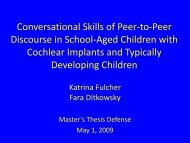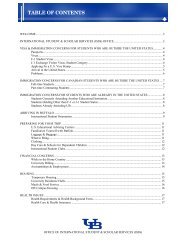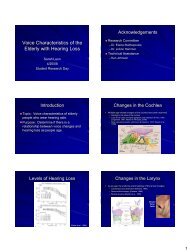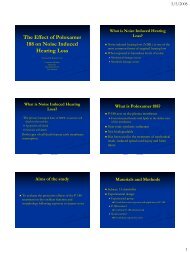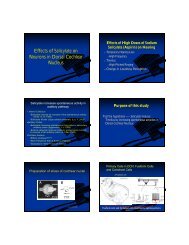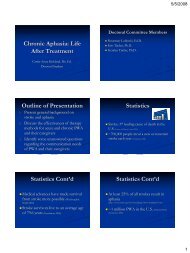Speech Disruptions in the Narratives of English-Speaking Children ...
Speech Disruptions in the Narratives of English-Speaking Children ...
Speech Disruptions in the Narratives of English-Speaking Children ...
You also want an ePaper? Increase the reach of your titles
YUMPU automatically turns print PDFs into web optimized ePapers that Google loves.
Types and Functions <strong>of</strong> <strong>Speech</strong> <strong>Disruptions</strong><br />
<strong>Speech</strong> disruptions occur <strong>in</strong> <strong>the</strong> steady flow <strong>of</strong> spontaneous<br />
discourse; <strong>the</strong>se <strong>in</strong>clude silent pauses and vocal<br />
hesitations (Kowal, O’Connell, & Sab<strong>in</strong>, 1975). Silent<br />
pauses are <strong>the</strong> periods <strong>of</strong> time when no phonation is be<strong>in</strong>g<br />
made dur<strong>in</strong>g spoken discourse. In research on speech<br />
disruptions, silent pauses typically refer to <strong>the</strong> silent <strong>in</strong>tervals<br />
that are equal to or greater than 250 ms (Goldman-<br />
Eisler, 1968). Silent <strong>in</strong>tervals <strong>of</strong> fewer than 250 ms are<br />
considered to serve an articulatory ra<strong>the</strong>r than cognitive<br />
function <strong>in</strong> speech production and are not counted as<br />
silent pauses.<br />
Vocal hesitations denote filled pauses, <strong>in</strong>terjections,<br />
repetitions, or revisions occurr<strong>in</strong>g dur<strong>in</strong>g spoken discourse<br />
(Dollaghan & Campbell, 1992; Kowal et al., 1975).<br />
Filled pauses refer to conventional but nonlexical onesyllable<br />
filler vocalizations (e.g., um, uh, ah), whereas<br />
<strong>in</strong>terjections refer to conventional words or phrases that<br />
do not contribute <strong>in</strong>formation to an utterance (e.g., I<br />
mean, well, like, you know; Clark & Fox Tree, 2002).<br />
Repetitions denote repeated l<strong>in</strong>guistic units (e.g.,<br />
segment, syllable, or word) that do not signal emphatic<br />
mean<strong>in</strong>g. Part-word repetition refers to repetition <strong>of</strong> segments<br />
(e.g., he p* picked up <strong>the</strong> nest) or syllables (e.g., <strong>the</strong><br />
bull was al* always <strong>the</strong>re) <strong>of</strong> a word. Whole-word repetition<br />
refers to <strong>the</strong> repetition <strong>of</strong> s<strong>in</strong>gle monosyllabic<br />
(e.g., but but she liked it) or multisyllabic words (e.g., <strong>the</strong><br />
girl was fly<strong>in</strong>g fly<strong>in</strong>g her kite). Phrasal repetition (e.g.,<br />
she is fly<strong>in</strong>g a kite a kite) and multi-word repetition (e.g.,<br />
He would go would go home) are both treated as wholeword<br />
repetitions. Revisions refer to “reliably recognizable<br />
modifications <strong>of</strong> a unit already produced by <strong>the</strong> speaker”<br />
(Dollaghan & Campbell, 1992, p. 62), which result <strong>in</strong> <strong>the</strong><br />
alteration <strong>of</strong> lexical, morphological, syntactic, semantic,<br />
or phonological material (Rispoli, 2003), as exemplified <strong>in</strong><br />
Example (1).<br />
(1) a. <strong>the</strong>n (<strong>the</strong> g*) <strong>the</strong> boy drownened. [lexical change]<br />
b. his mom picked up <strong>the</strong> basket and (ru*) ran <strong>in</strong>to<br />
<strong>the</strong> house. [morphological change]<br />
c. and <strong>the</strong> girl was fly<strong>in</strong>g (her kite) her new kite.<br />
[semantic change]<br />
d. <strong>the</strong> oldest bro<strong>the</strong>r didn’t know how to (sim) swim.<br />
[phonological change]<br />
F<strong>in</strong>ally, those l<strong>in</strong>guistic units that do not have a reliably<br />
identifiable relationship to o<strong>the</strong>r units, such as I will get<br />
<strong>in</strong> <strong>the</strong> money, are categorized as orphans.<br />
From a functional po<strong>in</strong>t <strong>of</strong> view, speech disruptions<br />
are <strong>the</strong> strategies that speakers adopt to solve <strong>the</strong> problems<br />
or breakdowns <strong>in</strong> sentence production (Clark & Fox<br />
Tree, 2002; Postma & Kolk, 1993). Breakdowns can be<br />
due to difficulty or errors <strong>of</strong> commission <strong>in</strong> form<strong>in</strong>g concepts<br />
or <strong>in</strong> activat<strong>in</strong>g l<strong>in</strong>guistic elements, such as syntactic<br />
frames (e.g., <strong>the</strong> + Noun) and lexical items (Rispoli,<br />
2003). Process<strong>in</strong>g difficulties dur<strong>in</strong>g sentence production<br />
may result <strong>in</strong> <strong>the</strong> occurrence <strong>of</strong> silent pauses, filled<br />
pauses, <strong>in</strong>terjections, or repetitions. The use <strong>of</strong> <strong>the</strong>se<br />
speech disruptions would allow <strong>the</strong> speaker more time to<br />
deal with <strong>the</strong>se difficulties. Silent pauses tend to occur<br />
when speakers encounter difficulties <strong>in</strong> form<strong>in</strong>g concepts,<br />
activat<strong>in</strong>g syntactic frames, or retriev<strong>in</strong>g <strong>the</strong> syntactic<br />
and semantic <strong>in</strong>formation (i.e., lemma) <strong>of</strong> lexical items<br />
(Levelt, 1989; Postma & Kolk, 1993). In onl<strong>in</strong>e conversation,<br />
<strong>the</strong> speaker is not allowed to pause for too long because<br />
this would cause him to lose <strong>the</strong> floor (Clark, 2002).<br />
The speaker may thus use filled pauses (e.g., um and uh)<br />
or <strong>in</strong>terjections to keep <strong>the</strong> floor when he predicts his own<br />
prolonged silences. The use <strong>of</strong> filled pauses and <strong>in</strong>terjections<br />
may also buy more time for <strong>the</strong> speaker to deal with<br />
process<strong>in</strong>g difficulties (Rispoli, 2003). Phrasal repetitions<br />
may <strong>in</strong>volve difficulties <strong>in</strong> form<strong>in</strong>g concepts or <strong>in</strong> activat<strong>in</strong>g<br />
syntactic frames, whereas word repetitions may result<br />
from difficulties <strong>in</strong> retriev<strong>in</strong>g <strong>the</strong> lemma <strong>in</strong>formation<br />
<strong>of</strong> lexical items. Part-word repetitions, <strong>in</strong> contrast, are<br />
duetodifficulties<strong>in</strong>retriev<strong>in</strong>g<strong>the</strong>lexeme<strong>in</strong>formation<br />
(i.e., phonological forms) <strong>of</strong> lexical items. The speaker<br />
repeats <strong>the</strong> phrase, word(s), or phoneme(s) to ga<strong>in</strong> more<br />
time for sentence plann<strong>in</strong>g and to keep <strong>the</strong> <strong>in</strong>tegrity <strong>of</strong><br />
<strong>the</strong> constituent (Clark, 2002; Maclay & Osgood, 1959).<br />
For <strong>in</strong>stance, consider <strong>the</strong> utterance (on <strong>the</strong>) on <strong>the</strong> farm.<br />
In <strong>the</strong> beg<strong>in</strong>n<strong>in</strong>g, <strong>the</strong> child retrieves <strong>the</strong> syntactic <strong>in</strong>formation<br />
<strong>of</strong> farm (i.e., noun) but not <strong>the</strong> semantic <strong>in</strong>formation.<br />
The phrase structure on <strong>the</strong> + N is also activated,<br />
and part <strong>of</strong> <strong>the</strong> phrase (e.g., on <strong>the</strong>) has been executed.<br />
The child may have to stop because he has not retrieved<br />
<strong>the</strong> semantic <strong>in</strong>formation <strong>of</strong> farm.Hemayuserepetitions<br />
(e.g., on <strong>the</strong> on <strong>the</strong> farm) to buy more time to retrieve <strong>the</strong><br />
semantic <strong>in</strong>formation <strong>of</strong> farm. In contrast to o<strong>the</strong>r types<br />
<strong>of</strong> speech disruptions, revisions result from errors <strong>of</strong><br />
commission <strong>in</strong> form<strong>in</strong>g <strong>in</strong>correct concepts or <strong>in</strong> activat<strong>in</strong>g<br />
<strong>in</strong>accurate l<strong>in</strong>guistic elements. Revisions take place<br />
when speakers detect and attempt to repair plann<strong>in</strong>g<br />
errors. Interjections, like I mean, can be used to signal a<br />
repair (e.g., <strong>the</strong> girl, I mean, <strong>the</strong> boy was worried). In<br />
summary, speech disruptions may serve as process<strong>in</strong>g<br />
strategies to buy time or repair errors, but <strong>the</strong>y do reflect<br />
<strong>the</strong> occurrence <strong>of</strong> process<strong>in</strong>g breakdowns <strong>in</strong> sentence<br />
production. Different types <strong>of</strong> process<strong>in</strong>g breakdowns<br />
result <strong>in</strong> different surface forms <strong>of</strong> speech disruption.<br />
<strong>Speech</strong> <strong>Disruptions</strong> <strong>in</strong> Typical<br />
Language Development<br />
Research on speech disruptions <strong>in</strong> typically develop<strong>in</strong>g<br />
children has shown that <strong>the</strong> production <strong>of</strong> <strong>the</strong>se disruptions<br />
is related to language development, specifically<br />
syntactic development. Kowal et al. (1975) exam<strong>in</strong>ed<br />
speech disruptions <strong>in</strong> spoken narratives by children at<br />
Downloaded from jslhr.asha.org on November 10, 2010<br />
Guo et al.: <strong>Speech</strong> <strong>Disruptions</strong> <strong>in</strong> SLI <strong>Narratives</strong> 723



